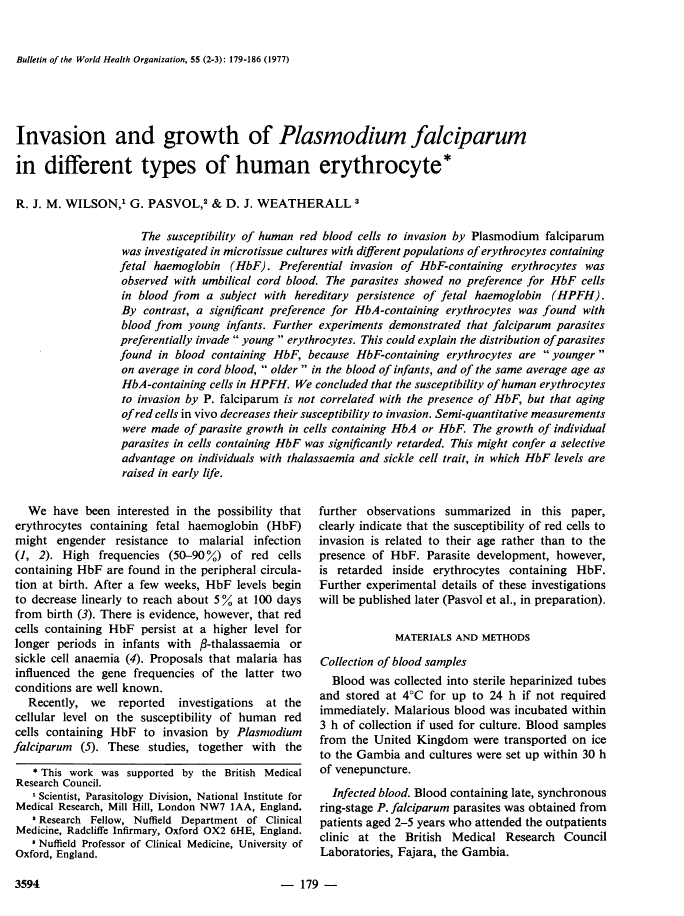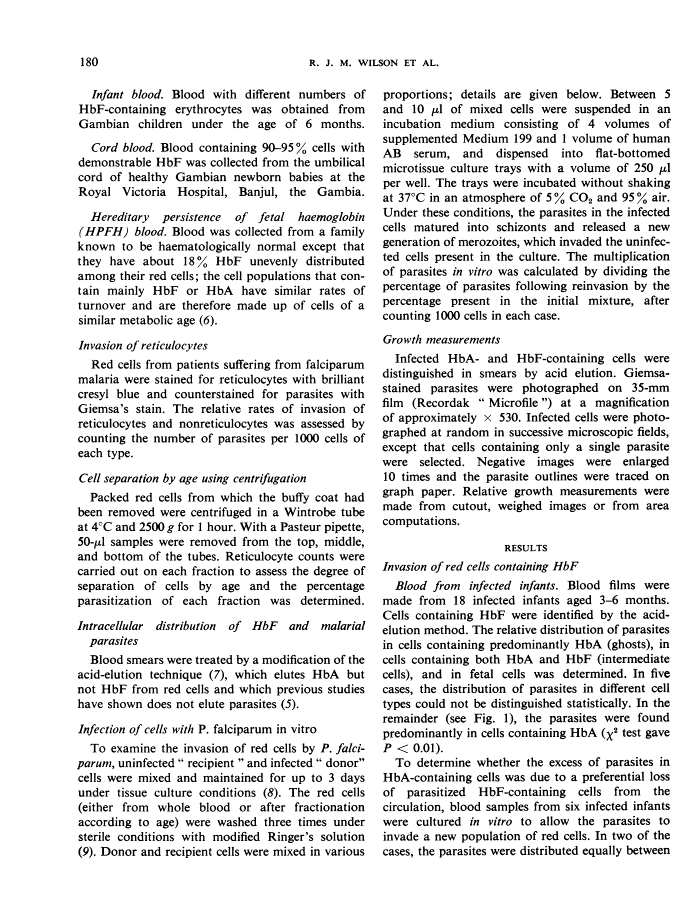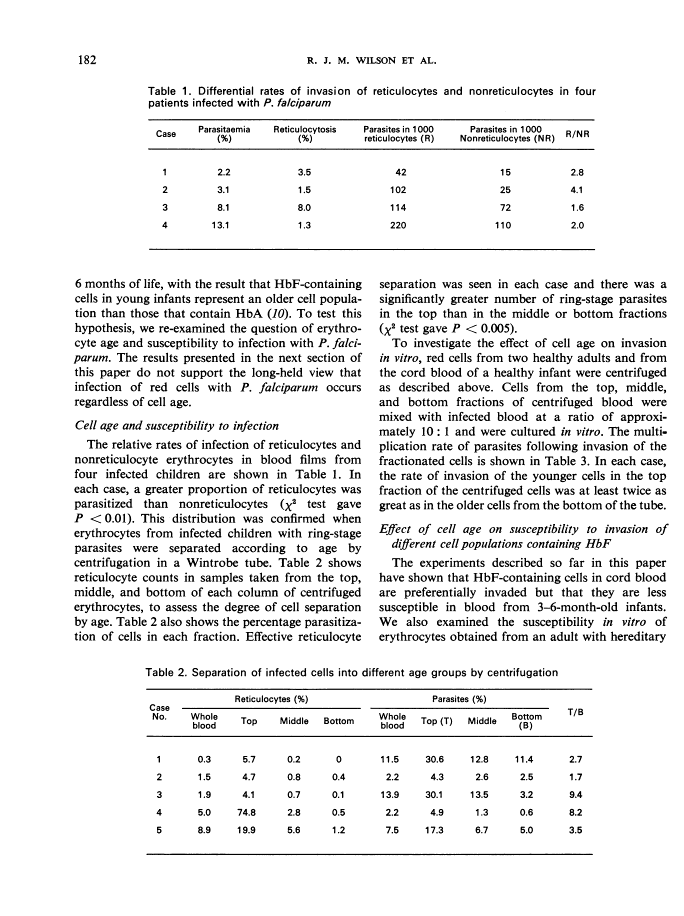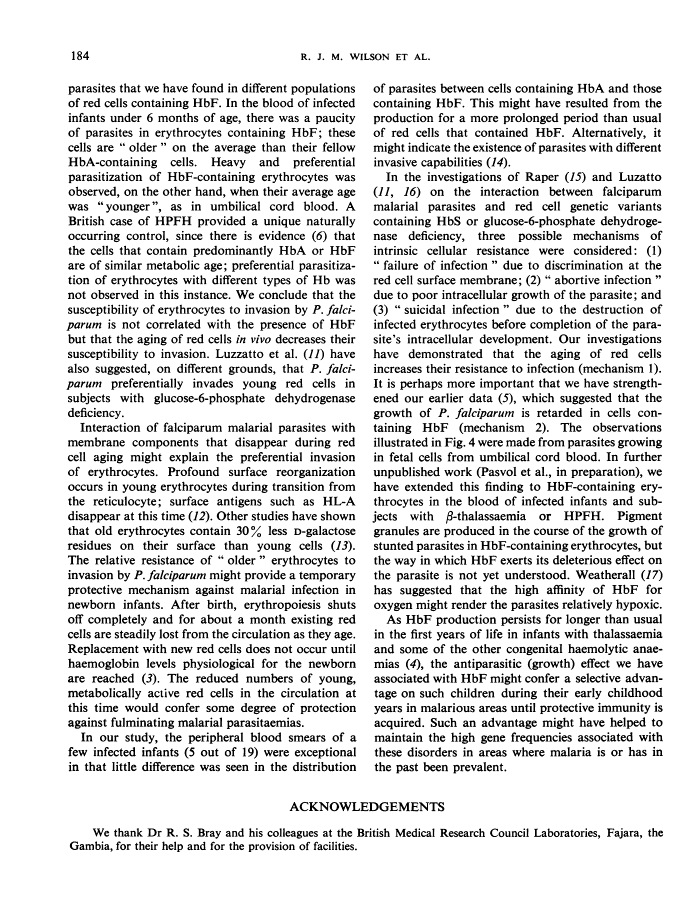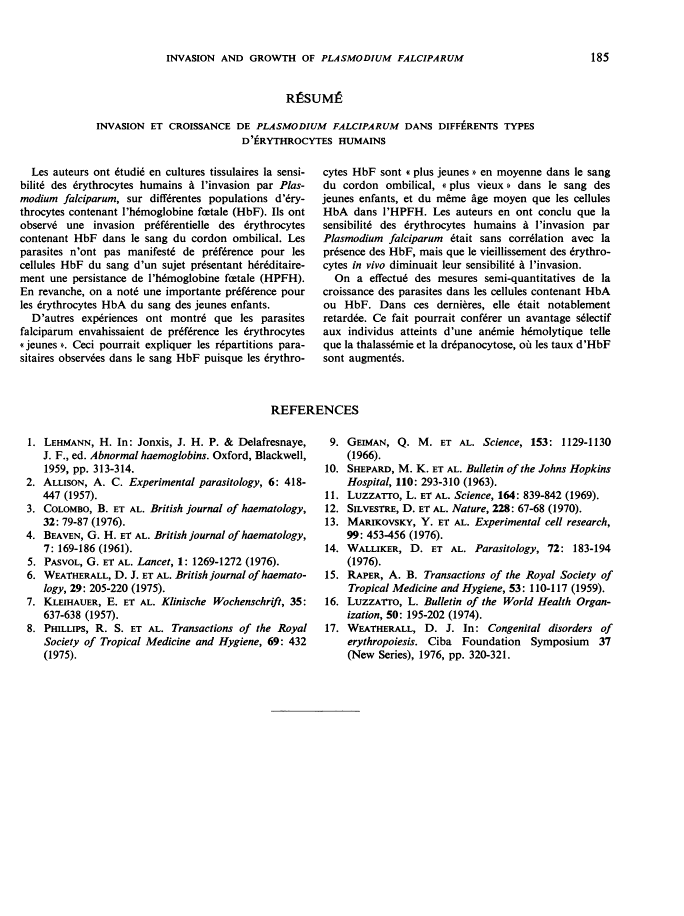Abstract
Free full text

Invasion and growth of Plasmodium falciparum in different types of human erythrocyte*
Abstract
The susceptibility of human red blood cells to invasion by Plasmodium falciparum was investigated in microtissue cultures with different populations of erythrocytes containing fetal haemoglobin (HbF). Preferential invasion of HbF-containing erythrocytes was observed with umbilical cord blood. The parasites showed no preference for HbF cells in blood from a subject with hereditary persistence of fetal haemoglobin (HPFH). By contrast, a significant preference for HbA-containing erythrocytes was found with blood from young infants. Further experiments demonstrated that falciparum parasites preferentially invade “young” erythrocytes. This could explain the distribution of parasites found in blood containing HbF, because HbF-containing erythrocytes are “younger” on average in cord blood, “older” in the blood of infants, and of the same average age as HbA-containing cells in HPFH. We concluded that the susceptibility of human erythrocytes to invasion by P. falciparum is not correlated with the presence of HbF, but that aging of red cells in vivo decreases their susceptibility to invasion. Semi-quantitative measurements were made of parasite growth in cells containing HbA or HbF. The growth of individual parasites in cells containing HbF was significantly retarded. This might confer a selective advantage on individuals with thalassaemia and sickle cell trait, in which HbF levels are raised in early life.
Full text
Full text is available as a scanned copy of the original print version. Get a printable copy (PDF file) of the complete article (875K), or click on a page image below to browse page by page. Links to PubMed are also available for Selected References.
Selected References
These references are in PubMed. This may not be the complete list of references from this article.
- ALLISON AC. Malaria in carriers of the sickle-cell trait and in newborn children. Exp Parasitol. 1957 Jul;6(4):418–447. [Abstract] [Google Scholar]
- Pasvol G, Weatherall DJ, Wilson RJ, Smith DH, Gilles HM. Fetal haemoglobin and malaria. Lancet. 1976 Jun 12;1(7972):1269–1272. [Abstract] [Google Scholar]
- KLEIHAUER E, BRAUN H, BETKE K. Demonstration von fetalem Hämoglobin in den Erythrocyten eines Blutausstrichs. Klin Wochenschr. 1957 Jun 15;35(12):637–638. [Abstract] [Google Scholar]
- Geiman QM, Siddiqui WA, Schnell JV. Plasma replacement for in vitro culture of Plasmodium knowlesi. Science. 1966 Sep 2;153(3740):1129–1130. [Abstract] [Google Scholar]
- SHEPARD MK, WEATHERALL DJ, CONLEY CL. Semi-quantitative estimation of the distribution of fetal hemoglobin in red cell populations. Bull Johns Hopkins Hosp. 1962 Jun;110:293–310. [Abstract] [Google Scholar]
- Luzzatto L, Usanga FA, Reddy S. Glucose-6-phosphate dehydrogenase deficient red cells: resistance to infection by malarial parasites. Science. 1969 May 16;164(3881):839–842. [Abstract] [Google Scholar]
- Silvestre D, Kourilsky FM, Nicolai MG, Levy JP. Presence of HLA antigens on human reticulocytes as demonstrated by electron microscopy. Nature. 1970 Oct 3;228(5266):67–68. [Abstract] [Google Scholar]
- Marikovsky Y, Lotan R, Lis H, Sharon N, Danon D. Agglutination and labeling density of soybean agglutinin on young and old human red blood cells. Exp Cell Res. 1976 May;99(2):453–456. [Abstract] [Google Scholar]
- Walliker D, Sanderson A, Yoeli M, Hargreaves BJ. A genetic investigation of virulence in a rodent malaria parasite. Parasitology. 1976 Apr;72(2):183–194. [Abstract] [Google Scholar]
Associated Data
Articles from Bulletin of the World Health Organization are provided here courtesy of World Health Organization
Citations & impact
Impact metrics
Citations of article over time
Article citations
F-erythrocytes promote Plasmodium falciparum proliferation in sickle cell disease.
Am J Hematol, 98(10):1598-1605, 16 Aug 2023
Cited by: 0 articles | PMID: 37584425 | PMCID: PMC11145631
Generation of red blood cells from stem cells: Achievements, opportunities and perspectives for malaria research.
Front Cell Infect Microbiol, 12:1039520, 14 Nov 2022
Cited by: 6 articles | PMID: 36452302 | PMCID: PMC9702814
Review Free full text in Europe PMC
Does fetal hemoglobin inhibit the malarial parasite Plasmodium falciparum?
Am J Hematol, 97(9):E325-E327, 30 Jul 2022
Cited by: 0 articles | PMID: 35834276 | PMCID: PMC9428829
Reciprocal positive effects on parasitemia between coinfecting haemosporidian parasites in house sparrows.
BMC Ecol Evol, 22(1):73, 02 Jun 2022
Cited by: 2 articles | PMID: 35655150 | PMCID: PMC9164529
Age-Related Changes in Malaria Clinical Phenotypes During Infancy Are Modified by Sickle Cell Trait.
Clin Infect Dis, 73(10):1887-1895, 01 Nov 2021
Cited by: 3 articles | PMID: 33738485 | PMCID: PMC8599196
Go to all (33) article citations
Similar Articles
To arrive at the top five similar articles we use a word-weighted algorithm to compare words from the Title and Abstract of each citation.
In vitro growth of Plasmodium falciparum in neonatal blood.
Malar J, 13:436, 18 Nov 2014
Cited by: 6 articles | PMID: 25406504 | PMCID: PMC4242501
Influence of carriage of hemoglobin AS and the Fc gamma receptor IIa-R131 allele on levels of immunoglobulin G2 antibodies to Plasmodium falciparum merozoite antigens in Gabonese children.
J Infect Dis, 192(11):1975-1980, 20 Oct 2005
Cited by: 22 articles | PMID: 16267770
Transgenic mice expressing human fetal globin are protected from malaria by a novel mechanism.
Blood, 92(7):2520-2526, 01 Oct 1998
Cited by: 41 articles | PMID: 9746793
Innate resistance to malaria: the intraerythrocytic cycle.
Blood Cells, 16(2-3):321-39; discussion 340-9, 01 Jan 1990
Cited by: 27 articles | PMID: 2257317
Review
